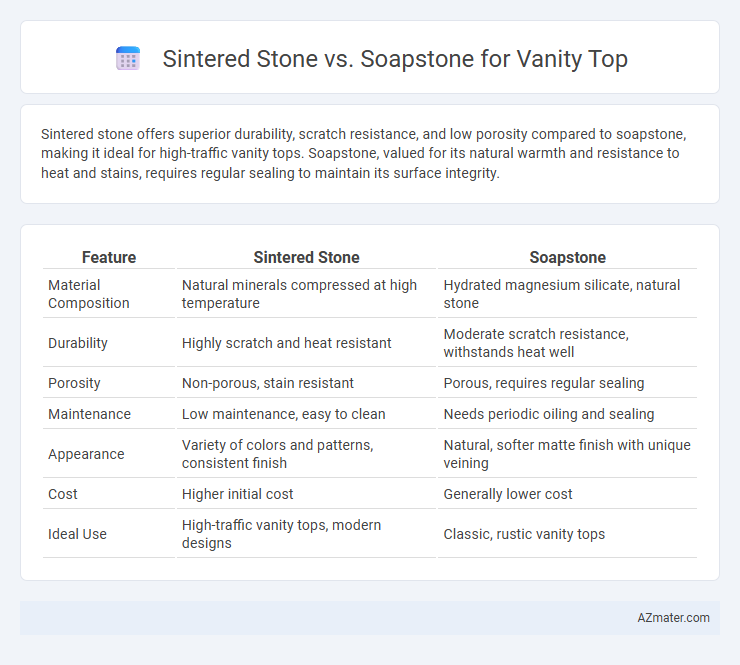Sintered stone offers superior durability, scratch resistance, and low porosity compared to soapstone, making it ideal for high-traffic vanity tops. Soapstone, valued for its natural warmth and resistance to heat and stains, requires regular sealing to maintain its surface integrity.
Table of Comparison
| Feature | Sintered Stone | Soapstone |
|---|---|---|
| Material Composition | Natural minerals compressed at high temperature | Hydrated magnesium silicate, natural stone |
| Durability | Highly scratch and heat resistant | Moderate scratch resistance, withstands heat well |
| Porosity | Non-porous, stain resistant | Porous, requires regular sealing |
| Maintenance | Low maintenance, easy to clean | Needs periodic oiling and sealing |
| Appearance | Variety of colors and patterns, consistent finish | Natural, softer matte finish with unique veining |
| Cost | Higher initial cost | Generally lower cost |
| Ideal Use | High-traffic vanity tops, modern designs | Classic, rustic vanity tops |
Introduction to Sintered Stone and Soapstone
Sintered stone, made through a high-pressure and high-temperature process, offers exceptional durability, scratch resistance, and a non-porous surface ideal for vanity tops. Soapstone, a natural metamorphic rock composed mainly of talc, provides a smooth, heat-resistant surface with a unique, matte finish that develops a patina over time. Both materials are favored for bathroom vanities due to their aesthetic appeal and functional properties, with sintered stone offering more stain resistance and soapstone excelling in heat retention.
Material Composition and Properties
Sintered stone is made from a blend of natural minerals and quartz, compressed at high temperatures to create an ultra-durable, non-porous surface resistant to scratches, stains, and heat. Soapstone consists primarily of talc and other metamorphic minerals, offering excellent heat resistance and a naturally smooth, soft texture that darkens over time but is more susceptible to scratches and requires regular oiling. Both materials provide unique aesthetic and functional qualities for vanity tops, with sintered stone excelling in durability and low maintenance, while soapstone offers a classic, warm appearance and tactile feel.
Aesthetic Differences: Colors and Patterns
Sintered stone offers a wide range of vibrant colors and intricate patterns that mimic natural materials like marble and granite, providing a modern and polished aesthetic for vanity tops. Soapstone, on the other hand, is characterized by its soft, muted hues of gray and green with subtle veining, creating a more rustic and natural appearance. The color stability of sintered stone is higher under UV exposure, while soapstone develops a unique patina over time, enhancing its organic beauty.
Durability and Strength Comparison
Sintered stone offers superior durability and strength compared to soapstone, with resistance to scratches, heat, and stains due to its engineered composition of natural minerals. Soapstone, while softer and more prone to surface scratches, excels in heat resistance and develops a unique patina over time, but it requires regular maintenance to prevent wear. For vanity tops, sintered stone is ideal for high-traffic environments demanding long-lasting robustness, whereas soapstone suits those valuing natural aesthetics and moderate durability.
Resistance to Stains, Heat, and Scratches
Sintered stone offers superior resistance to stains, heat, and scratches due to its dense, non-porous composition created through high-pressure and high-temperature processes, making it highly durable for vanity tops. Soapstone, while naturally heat-resistant and less prone to staining because of its dense structure, is softer and more susceptible to scratches and denting compared to sintered stone. Choosing sintered stone provides enhanced long-term performance and minimal maintenance, whereas soapstone requires periodic sealing and careful handling to maintain its surface integrity.
Maintenance and Cleaning Requirements
Sintered stone requires minimal maintenance due to its non-porous surface, resisting stains and scratching without the need for sealing. Soapstone, a natural material, demands regular oiling to maintain its appearance and prevent surface wear, although it resists bacteria and chemical damage effectively. Cleaning sintered stone involves simple mild soap and water, while soapstone benefits from gentle cleaning to avoid abrasive damage and preserve its matte finish.
Installation Process and Versatility
Sintered stone offers superior ease of installation for vanity tops due to its lightweight, uniform thickness, and large slab sizes, enabling quicker cuts and seamless fitting. Soapstone, being denser and softer, requires more careful handling and specialized tools during installation to prevent chipping and damage. Sintered stone's resistance to heat, stains, and scratching enhances its versatility in bathroom environments compared to the more porous, reactive nature of soapstone.
Cost and Value for Money
Sintered stone offers a higher upfront cost than soapstone but provides superior durability, stain resistance, and low maintenance, making it a cost-effective choice over time for vanity tops. Soapstone generally costs less initially, with a softer, natural feel, but requires regular sealing and is more prone to scratches and etching, which could increase long-term maintenance expenses. Evaluating cost against longevity and upkeep, sintered stone delivers better value for money for homeowners seeking a permanent, low-maintenance vanity surface.
Sustainability and Environmental Impact
Sintered stone exhibits superior sustainability due to its production process involving natural minerals fused under high heat and pressure, creating a durable and non-porous surface that resists scratches and stains, reducing the need for chemical cleaners. Soapstone, a natural metamorphic rock, is environmentally friendly because it requires minimal processing and can last for decades with proper maintenance, though its softness may lead to more frequent repairs or replacements. Both materials offer eco-conscious choices, but sintered stone's resistance to damage and low maintenance contribute to a longer lifecycle and decreased environmental footprint in vanity top applications.
Which is Better: Sintered Stone or Soapstone for Vanity Tops?
Sintered stone offers superior durability, scratch resistance, and heat tolerance compared to soapstone, making it an excellent choice for vanity tops in high-traffic bathrooms. Soapstone provides a naturally smooth, warm surface with excellent chemical resistance but requires regular sealing and maintenance to prevent staining and etching. For long-term performance and minimal upkeep, sintered stone is generally considered the better material for vanity tops.

Infographic: Sintered stone vs Soapstone for Vanity Top
 azmater.com
azmater.com